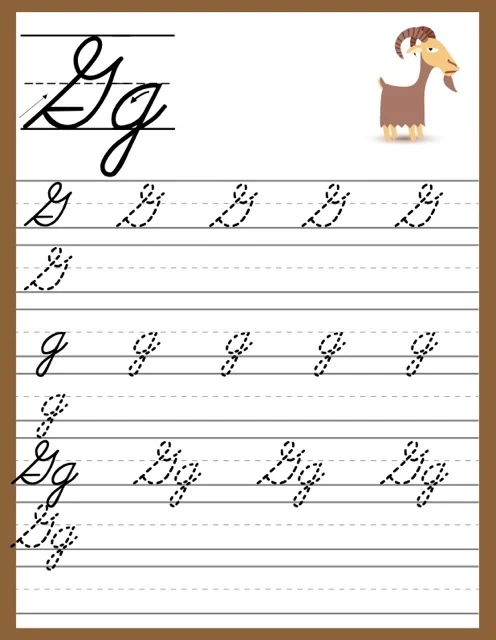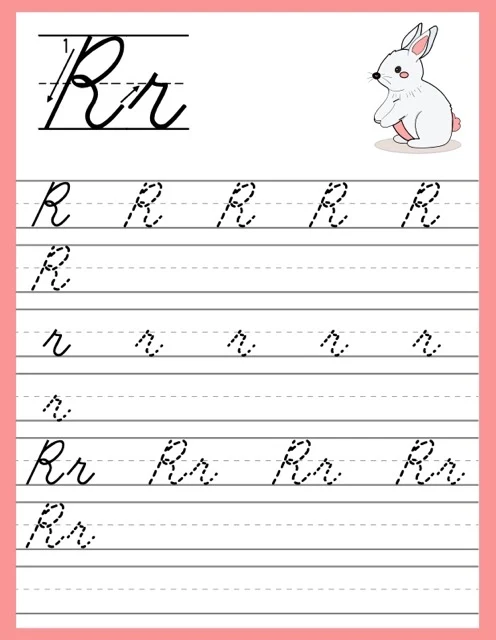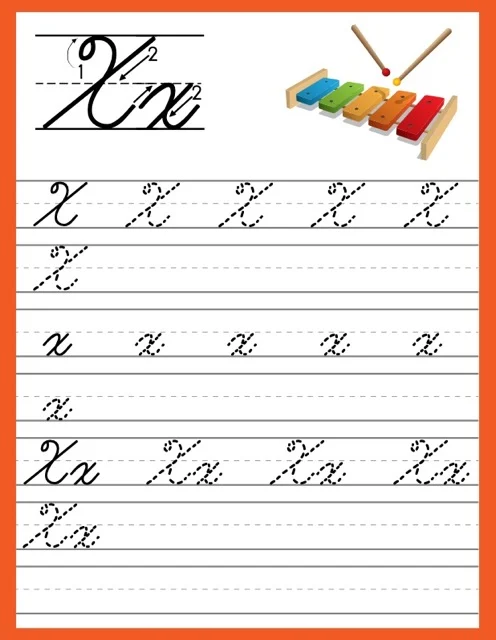Cursive Alphabet Tracing Guides: An Analysis
This briefing document analyzes cursive alphabet tracing guides, examining their purpose, audience (children and adults), structure (alphabetical, uppercase and lowercase letters), and benefits (improved fine motor skills, cognitive function, and handwriting fluency). The analysis emphasizes the importance of consistent practice and the use of engaging visuals, especially for children. Supplementary resources and the enduring relevance of cursive writing in the digital age are also discussed. Further research areas include the history of cursive and its future in education.
Cursive Alphabet Tracing Guides: A Comprehensive Analysis
Briefing Document: Cursive Alphabet Tracing Guides
Overview: This briefing document analyzes various sources related to cursive alphabet tracing guides, including their purpose, target audience, organization, benefits, and usage.
Key Themes:
1.
Purpose and Target Audience: Cursive alphabet tracing guides serve as tools for individuals to practice and enhance their cursive writing skills. These guides cater to a broad audience, ranging from children and students to adults seeking to learn or improve their cursive handwriting. ("Cursive Alphabet Tracing Guide" FAQ 1 & 2)
2.
Structure and Content: These resources typically follow an alphabetical organization, dedicating separate pages to each letter, showcasing both uppercase and lowercase versions. This systematic structure facilitates focused practice on individual letters. ("Cursive Writing Study Guide" Short Answer Key 3)
3.
Benefits of Cursive Writing: Practicing cursive writing offers multiple benefits, encompassing:
○
Enhanced fine motor skills and handwriting fluency
○
Improved letter recognition
○
Cognitive benefits such as boosted memory retention and cognitive function
○
Added personal touch and aesthetic appeal to written communication. ("Cursive Alphabet Tracing Guide" FAQ 4; "Cursive Writing Study Guide" Short Answer Key 4 & 10)
4.
Usage and Best Practices: Utilizing a pen or pencil, users trace over provided letterforms, gradually increasing pressure with growing confidence. Consistent practice is paramount for skill improvement. ("Cursive Alphabet Tracing Guide" FAQ 5 & 7; "Cursive Writing Study Guide" Short Answer Key 6)
5.
Supplementary Resources: Websites, workbooks, and mobile applications offer supplementary practice material and guidance, further enriching the learning experience. ("Cursive Alphabet Tracing Guide" FAQ 8; "Cursive Writing Study Guide" Short Answer Key 7)
6.
Visual Appeal and Engagement: Notably, the "Testing Theme: Cursive Alphabet Trace.pdf" resource incorporates colorful illustrations and engaging themes, potentially making the practice more enjoyable for children. This suggests a specific focus on making cursive learning appealing to younger audiences.
Important Facts and Quotes:
●
“Consistent practice is crucial for improving cursive writing skills as it reinforces proper letter formation and muscle memory.” ("Cursive Writing Study Guide" Short Answer Key 6)
●
“Cursive alphabet tracing guides for children often incorporate colorful illustrations, engaging themes, and playful fonts to enhance the learning experience.” ("Cursive Writing Study Guide" Short Answer Key 9)
Analysis:
The sources highlight the enduring relevance of cursive writing in contemporary society despite the rise of digital communication. Cursive alphabet tracing guides serve as accessible tools for individuals of all ages to learn, practice, and reap the multifaceted benefits of cursive writing. The incorporation of visually appealing elements in guides targeting children underscores the importance of fostering engagement and enjoyment in the learning process.
Further Research:
The provided sources spark further inquiry into the historical evolution of cursive writing, the ongoing debate surrounding its place in modern education systems, and the potential impact of technology on its future. Exploring these areas can provide a comprehensive understanding of cursive writing’s role and significance in the 21st century.
Cursive Alphabet Tracing Guide
Cursive Alphabet Trace FAQ
1. What is the purpose of this resource?
This resource is designed to help individuals practice and improve their cursive handwriting skills. It provides traceable letterforms for the entire alphabet, both uppercase and lowercase.
2. Who is this resource for?
This resource is suitable for anyone looking to learn or improve their cursive writing, including children, students, and adults. It can be particularly helpful for beginners or those who want to refresh their cursive skills.
3. How is this resource organized?
The resource is organized alphabetically, with separate pages dedicated to each letter of the alphabet. Each page features multiple lines for tracing the uppercase and lowercase versions of the letter.
4. What are the benefits of practicing cursive writing?
Practicing cursive writing can improve fine motor skills, handwriting fluency, and letter recognition. It can also enhance cognitive function and memory retention. Additionally, cursive writing can add a personal touch to written communication.
5. How should I use this resource?
Use a pen or pencil to carefully trace over the provided letterforms. Start with light strokes and gradually increase pressure as you gain confidence. Focus on the correct formation and spacing of the letters.
6. Can I use this resource with different writing tools?
Yes, you can use a variety of writing tools with this resource, such as pens, pencils, markers, or crayons. Experiment with different tools to find what works best for you.
7. How often should I practice?
The frequency of practice depends on your individual goals and needs. Regular, consistent practice is key to improving your cursive writing skills. Aim for at least 15-20 minutes of practice several times a week.
8. Are there any additional resources available?
Yes, there are numerous online and offline resources available to supplement your cursive writing practice. Look for websites, workbooks, and apps that offer additional guidance and activities.
Cursive Writing Study Guide
Cursive Writing Study Guide
Short Answer Quiz
1.
What is the primary purpose of a cursive alphabet tracing guide?
2.
Who can benefit from using a cursive alphabet tracing guide?
3.
Describe the typical organization of a cursive alphabet tracing guide.
4.
List three cognitive or physical benefits attributed to practicing cursive writing.
5.
What writing tools are recommended for use with a cursive alphabet tracing guide?
6.
Explain the importance of consistent practice in improving cursive writing skills.
7.
What additional resources can be utilized to supplement cursive writing practice?
8.
What type of strokes should be used when beginning to trace cursive letters?
9.
What visual elements are frequently incorporated in cursive alphabet tracing guides for children?
10.
Why might cursive writing add a personal touch to communication?
Short Answer Key
1.
The primary purpose of a cursive alphabet tracing guide is to help individuals practice and improve their cursive handwriting skills.
2.
Cursive alphabet tracing guides can benefit anyone looking to learn or improve their cursive writing, including children, students, and adults.
3.
Cursive alphabet tracing guides are typically organized alphabetically, with separate pages for each letter, including uppercase and lowercase versions.
4.
Practicing cursive writing can improve fine motor skills, handwriting fluency, and letter recognition. It can also enhance cognitive function and memory retention.
5.
Recommended writing tools for cursive tracing include pens, pencils, markers, and crayons.
6.
Consistent practice is crucial for improving cursive writing skills as it reinforces proper letter formation and muscle memory.
7.
Additional resources for cursive writing practice include websites, workbooks, and mobile applications.
8.
When beginning to trace cursive letters, start with light strokes and gradually increase pressure as confidence grows.
9.
Cursive alphabet tracing guides for children often incorporate colorful illustrations, engaging themes, and playful fonts to enhance the learning experience.
10.
Cursive writing can add a personal touch to communication by reflecting individual handwriting style and creating a visually distinctive and elegant aesthetic.
Essay Questions
1.
Analyze the historical significance of cursive writing and discuss its evolution over time.
2.
Evaluate the arguments for and against the continued teaching of cursive writing in modern education systems.
3.
Explore the relationship between cursive writing and cognitive development, specifically addressing its potential benefits for memory, attention, and creativity.
4.
Compare and contrast the advantages and disadvantages of cursive writing versus print writing in various contexts, such as personal communication, professional documents, and creative expression.
5.
Discuss the role of technology in the preservation and future of cursive writing, considering the impact of digital communication and the availability of assistive writing tools.
Glossary of Key Terms
●
Cursive Writing: A style of handwriting characterized by flowing, connected letters.
●
Tracing: The act of copying a letter or shape by following its outline.
●
Fine Motor Skills: The coordination of small muscles in the hands and fingers.
●
Handwriting Fluency: The ability to write smoothly and effortlessly.
●
Letter Recognition: The ability to identify and name letters of the alphabet.
●
Cognitive Function: Mental processes such as thinking, remembering, and problem-solving.
●
Memory Retention: The ability to store and recall information.
●
Uppercase: Capital letters.
●
Lowercase: Small letters.
●
Font: A set of characters with a specific style and size.
●
Muscle Memory: The ability to perform a movement automatically without conscious effort.
●
Digital Communication: The exchange of information using electronic devices.
●
Assistive Writing Tools: Devices or software that help individuals with writing difficulties.

























